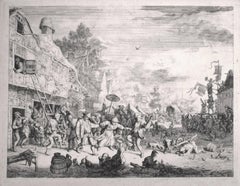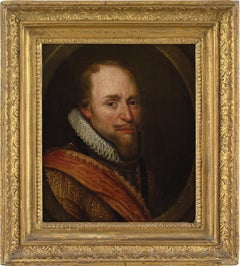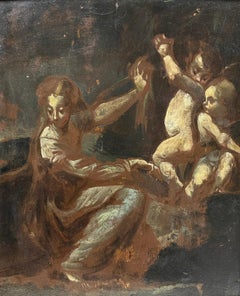Cornelis Dusart Art
Dutch, 1660-1704
Cornelis Dusart was a Dutch genre painter, draftsman and printmaker. He was born in Haarlem. Dusart was a pupil of Adriaen van Ostade from about 1675–79 and was accepted into the Haarlem Guild of St. Luke in 1679. His works are similar in style and subject to those of his mentor.
to
2
1
1
2
1
2
1
Overall Height
to
Overall Width
to
3
3
3
2
2
1
1
3
3
6,857
3,168
2,516
1,217
2
1
1
1
Artist: Cornelis Dusart
Portrait of a Man
By Cornelis Dusart
Located in London, GB
Circle of Cornelis Dusart
Dutch 1660 - 1704
Portrait of a Man
Oil on panel
Image size: 7¾ x 5¼ inches
Giltwood frame
Cornelis Dusart
Cornelis ...
Category
17th Century Old Masters Cornelis Dusart Art
Materials
Panel, Oil
The Large Village Fair
By Cornelis Dusart
Located in Chicago, IL
The Large Village Fair, 1685
Etching
268 x 377 mm.; 10 1/2 x 13 1/4 inches
Watermark:
Arms of Amsterdam
Provenance:
H. Freiherr von und zu Aufsess (Lugt 2749)
M. Menge (Lugt 1893a).
References:
Hollstein 16
Notes:
A fine, early impression (before spots on the sky) of one of Dusart’s most powerful and fanciful works.
Concerning the provenances of this etching:
Hans von und zu Aufsess (1801-1872) was a great book lover and also a major collector of Old Master prints. He was one of the founders, in 1852, of the Germanisches Museum in Nürnberg and was that museum’s director until 1862. Mas Menge (died in 1945) was a famous violinist and also a major collector of Old Master prints and drawings.
Category
17th Century Old Masters Cornelis Dusart Art
Materials
Etching
The Kermesse - Original Etching by Cornelis Dusart - 1686
By Cornelis Dusart
Located in Roma, IT
Signed and dated on the left lower margin of the plate: “Corn. Dusart fe. 1685”. On Netherlandish watermarked paper. Very good conditions.
Bartsch n.16. Beautiful etching describes a scene of ordinary peasant’s life.
Passepartout included : 47.5 x 56 cm
Cornelis Dusart (Haarlem, 1660 - 1704), Netherlandish painter and engraver, apprentice of Adriaen van Ostade, he was accepted by the Corporation of Saint Luca...
Category
17th Century Old Masters Cornelis Dusart Art
Materials
Etching
Related Items
Michiel Jansz. Van Mierevelt (Follower), Portrait of Maurice of Orange
Located in Cheltenham, GB
This early to mid-17th-century oil on panel depicts Maurice of Nassau (1567-1625), Prince of Orange. It’s a bust-length portrait, presented in a feigned oval, after a full length by ...
Category
Mid-17th Century Old Masters Cornelis Dusart Art
Materials
Oil, Wood Panel
Angelic Cherubs with Classical Figure in Wilderness Finely Painted Preparatory
Located in Cirencester, Gloucestershire
Figure with Cherubim in Wilderness
Italian School, 17th century
oil painting on wood panel
framed 13 x 11 inches
condition: overall for its age very good, though the work is most likely a preparatory...
Category
17th Century Old Masters Cornelis Dusart Art
Materials
Oil, Wood Panel
Portrait of three children - Bernhard Keil (1624-1687)
Located in Gent, BE
“A portrait of three children, one of them holding a basket of grapes, while another plays the flute”
Oil on canvas
Housed in a blackened 17th-century frame.
We'd like to thank dr...
Category
17th Century Old Masters Cornelis Dusart Art
Materials
Oil, Panel
Portrait of Gentleman, Thomas Bruce, Earl of Elgin c.1638 Manor House Provenance
Located in London, GB
Titan Fine Art present this picture which formed part of a historic collection of an English aristocratic family, Lord and Lady Sandys at their magnificent baroque and Regency Grade-...
Category
17th Century Old Masters Cornelis Dusart Art
Materials
Oil, Wood Panel
H 18.9 in W 16.15 in D 1.58 in
The Card Players by a Flemish 1600s Artist
By Flemish School, 17th Century
Located in Stockholm, SE
Flemish 1600s School
The Card Players
oil on oak panel
panel dimensions 22.5 x 20 cm
frame included
Provenance:
From a Swedish private collection.
Condition:
Flat and stabl...
Category
17th Century Old Masters Cornelis Dusart Art
Materials
Oak, Oil, Panel
Veduta del Tempio della Fortuna Virile, from Raccolta delle più belle Vedute ...
By Giuseppe Vasi
Located in Middletown, NY
By Giuseppe Vasi after Giovanni Piranesi: Etching and engraving with hand coloring in watercolor on laid paper with an E and R watermark, full margins. Minor...
Category
Late 18th Century Old Masters Cornelis Dusart Art
Materials
Watercolor, Laid Paper, Engraving, Etching
19th century portrait painted in St Petersburg in 1819
Located in London, GB
Signed, inscribed and dated, lower right:
'Geo Dawe RA St Petersburgh 1819', also signed
with initials, lower centre: 'G D RA'; and signed and inscribed verso:
'Geo Dawe RA Pinxit 1819 St Petersburgh';
Also inscribed on the stretcher by Cornelius Varley with varnishing instructions.
Collections:
Private collection, UK, 2010
Literature:
Galina Andreeva Geniuses of War, Weal and Beauty: George Dawe...
Category
19th Century Old Masters Cornelis Dusart Art
Materials
Canvas, Oil
Man in Tavern Smoking a Pipe /// Old Masters Dutch David Teniers Portrait Face
By David Teniers the Younger
Located in Saint Augustine, FL
Artist: Unknown (Circle of David Teniers the Younger, Flemish, 1610-1690)
Title: "Man in Tavern Smoking a Pipe"
*No signature found
Circa: 1690
Medium: Original Oil Painting on Wooden Board
Framing: Framed in an antique gold gesso frame...
Category
1690s Old Masters Cornelis Dusart Art
Materials
Gold Leaf
Venus Lamenting over the Death of Adonis
By Herman van Swanevelt
Located in Middletown, NY
c. 1654. Etching with engraving on thin laid paper with an early and large unidentified watermark with a sundial and a many-pointed star, and an unidentified collector's stamp in the...
Category
Mid-17th Century Old Masters Cornelis Dusart Art
Materials
Handmade Paper, Engraving, Etching
Portrait Gentleman Black Slashed Doublet & Orange Sash Dutch Oil on Panel c.1650
By Bartholomeus van der Helst
Located in London, GB
This exquisite portrait of a gentleman depicted in a sumptuous black doublet edged with silver and slashed sleeves is an excellent example of the type of portrait fashionable in England and the Low Countries during the 17th century. The confident pose, striking orange sash - the colour of the house of Orange Nassau - and the leather gorget imbue the sitter with a sense of masculinity and power. The profusely decorated costume is of the highest quality and de rigueur of an elite class - the artist has carefully cultivated this portrait to emphasise the sitter’s wealth and standing in the society that he belonged to. The casual pose, with one arm resting on a hip, is much less formal than earlier decades, and it speaks of ‘sprezzatura’ – one’s appearance should not appear laborious, but instead, effortless.
The oil on cradled panel portrait can be dated to circa 1650 based on the hairstyle and the attire - small falling collar, short doublet (doublets reduced in size to just below the ribcage in the late 1650’s), and the type of slashed sleeves with the sleeve seams left open to reveal the white fabric.
The demand for portraits in the Netherlands was great in the 17th century. Bartholemeus van der Helst was considered to be one of the leading portrait painters of the Dutch Golden Age surpassing even Rembrandt as the most sought-after portraitist in Harlaam. The Dutch Golden Age, roughly spanning the 17th century, was a period when Dutch trade, science, military, and art were among the most acclaimed in the world. Dutch explorers charted new territory and settled abroad. Trade by the Dutch East-India Company thrived, and war heroes from the naval battles were decorated and became national heroes. During this time, The Dutch Old Masters began to prevail in the art world, creating a depth of realistic portraits of people and life in the area that has hardly been surpassed. The Golden Age painters depicted the scenes that their discerning new middle-class patrons wanted to see. This new wealth from merchant activities and exploration combined with a lack of church patronage, shifted art subjects away from biblical genres. Still life’s of items of everyday objects, landscapes, and seascapes reflecting the naval and trade power that the Republic enjoyed were popular. The new wealthy class were keen to have their portraits commissioned and many artists worked in this lucrative field. Such was the popularity of art that everyone had a painting, even the humble butcher, and hundreds of thousands of paintings were produced.
By tradition the sitter is Maarten Tromp (1598-1653) who was an Admiral in the Dutch Navy (the reverse of the portrait contains an old handwritten inscription “van Tromp”). Certainly, the distinctive orange sash is similar to those worn by officers of the Dutch army in the Netherlands who served under the Princes of Orange and the House of Nassau. However, it should be noted that the physiognomy differs from other images of Tromp.
Tromp was the oldest son of Harpert Maertensz, a naval officer and captain. He joined the Dutch navy as a lieutenant in July 1622 and was later promoted from captain to Lieutenant-Admiral of Holland and West Frisia in 1637. In 1639, during the Dutch struggle for independence from Spain, Tromp defeated a large Spanish fleet bound for Flanders at the Battle of the Downs, which marked an enormous change - the end of Spanish naval power. He was killed in action during the First Anglo-Dutch War in 1653 where he commanded the Dutch fleet in the battle of Scheveningen.
Gloves were an absolutely vital accessory and the elaborate pair in this portrait are embellished with threads of silk and precious metals and salmon-coloured lining. He wears only one glove and holds the other, providing an opportunity to better display the cuffs and detail on his right wrist and forearm. The gloves are probably made from the most prized leather which came from Spain, in particular from Cordova. Cordovan leather was tanned with a special vegetal process that left it both highly impermeable and divinely soft. King Charles I, posed in a rather relaxed manner for Daniel Mytens’s portrait in 1631, is wearing gloves and boots in matching Cordovan leather. The hide is thick, but you can see just how supple it is from the way the gauntlet dimples and the long boot legs fold over themselves, rippling and wrinkling at the ankles.
Apart from keeping hands warm the use of gloves during the 15th through the 19th centuries were full of symbolism and they were worn regardless of the season. They kept the skin unblemished - soft, smooth hands were considered highly attractive. This combination of necessity and proximity to bare skin made gloves a deeply personal gift and they took on a strong symbolic significance and were regarded as emblematic of fidelity and loyalty for hundreds of years. Such was the importance of their symbolism was that some gloves were never intended to be worn at all. Their luxury made them ideal gifts at court, and so in the 15th and 16th centuries, ambassadors often presented them as symbols of loyalty.
Until the mid-19th century, it was customary to give gloves as tokens to guests at weddings and to mourners at funerals. Gentleman often gifted their bride-to-be with a pair of gloves (the obligatory gift) and were handed over at the betrothal and put on display before the wedding took place. It was probably their direct contact with the skin that led to the eroticism of gloves. Not only were pairs often exchanged between lovers, but from the 16th to the 18th centuries, it was common practice to remove one glove and give it as a gift to a favourite. The idea of the item being presented still warm from the wearer’s hand is certainly suggestive. Following the death of King George IV, his executors purportedly found over a thousand mismatched ladies’ gloves among his possessions.
The sentiment of a 17th-century poem reveals the popularity of the practice: “Come to our wedding to requite your loves / Shew us your hands and we’ll fit you with gloves.” Such generosity might be pricey for the hosts, but gloves of varying quality could be offered depending on the status of the recipient. Pairs made with the finest Spanish leather might be reserved for immediate family, while coarse sheep’s leather could be distributed among the servants and tradesmen. The apportioning of quality according to class provided a very clear message of the gloves’ intended use. For refined guests, they were decoration; for the lower classes, they were functional.
Bartholomeus van der Helst...
Category
17th Century Old Masters Cornelis Dusart Art
Materials
Wood Panel, Oil
H 38.59 in W 31.89 in D 2.76 in
18th century antique portrait Edmund Hoyle Circle of James Latham, Edmund Hoyle,
Located in York, GB
18th century Bust portrait of a gentleman in a blue coat with gold buttons (Said to be Edmund Hoyle, inventor of Whist)
circle of James Latham. Housed in a gilt frame the size overall is 71 x 84 cm (28 x 33 inches approx) whilst the painting is
56 x 69 cm ( 22 x 27 inches approx)
The overall condition is very good having had some restoration. The painting has been relined, cleaned and re varnished.
There has been some strengthening/overpainting. There is a Rectangular patch repair along lower edge, centre, reverse approximately 5 x 7cm with associated retouching to front,all essentially done sympathetically.
some fine stable craquelure throughout. Some minor self coloured losses to frame. None of the above detracting from
a very attractive portrait.
Edmond Hoyle
Edmond Hoyle
English card game authority, "the Father of whist"
Born 1672 England Died 29 August 1769 (aged 96–97)
London, England
Edmond Hoyle (1672 – 29 August 1769)[1] was a writer best known for his works on the rules and play of card games. The phrase "according to Hoyle" came into the language as a reflection of his generally perceived authority on the subject
James Latham
James Latham was born in Thurles, County Tipperary, Ireland and possibly related to the family of Lathams of Meldrum and Ballysheehan. After some practice of his art, Latham studied for an academic year in Antwerp (1724–25) where he became a Master of the Guild of St Luke. He returned to Dublin by 1725, and may have visited England in the 1740s, as the influence of Joseph Highmore, as well as Charles Jervas and William Hogarth, is evident in his work of this period. Anthony Pasquin memorably dubbed Latham "Ireland's Van Dyck". Latham died in Dublin on 26 January 1747.
Several of James Latham's portraits are in the National Gallery of Ireland collection in Dublin; one is of the famous MP Charles Tottenham (1694–1758) of New Ross, Co. Wexford, "Tottenham in his Boots" (Cat. No.411) and a second is a portrait of Bishop...
Category
Mid-18th Century Old Masters Cornelis Dusart Art
Materials
Oil
Free Shipping
H 33.08 in W 27.96 in D 1.97 in
The Veronica of the Virgin (Verónica de la Virgen)
Located in New York, NY
The panel has been attributed both to Joan de Joanes and his son Vicente Macip Comes (Valencia, ca. 1555 – 1623).
Provenance:
Private Collection, England, by 1886 (according to stencils on the reverse)
Private Collection, New Jersey, until 2010
The Veil of Veronica, often called the Sudarium, is one of the most important and well-known relics of Christ. According to legend, Veronica offered Christ her veil as he carried the cross to his crucifixion. He wiped his face with the veil, which left the cloth miraculously imprinted with his image. Depictions of Christ’s face on a veil, or simply images that focused in on Christ’s face, were treasured objects of religious devotion. The popularity of this format also inspired similar images of the face of the Virgin.
The iconographic type of the present painting is known as the Veronica of the Virgin, which was especially favored in late medieval and early Renaissance Spain. Distinct from the images of the suffering Christ, the Veronica of the Virgin is based on the legend that Saint Luke painted a portrait of Mary from life. Although scholars have sometimes mistaken them for portraits of Queen Isabella I of Castile (known as Isabel la Católica) or as a depiction of Saint Maria Toribia (known as María de la Cabeza, or, Mary of the Head), paintings like this one were clearly intended as images of the Virgin in the style of Saint Luke’s lost portrait.
The Veronica of the Virgin was especially popular in Valencia, and depictions of this subject produced there all stem back to one visual prototype: a Byzantine image in the city’s cathedral (Fig. 1). This early treatment of the Veronica was given to the cathedral in 1437 by Martin the Humane, King of Aragon and Valencia, who promoted religious veneration of the Veronica of the Virgin as part of the celebration of the Immaculate Conception of Mary. This devotion spread throughout Martin’s kingdom and particularly took hold in Valencia, where the Byzantine image resided. The image, which is displayed in a gold reliquary...
Category
16th Century Old Masters Cornelis Dusart Art
Materials
Oil, Wood Panel
Cornelis Dusart art for sale on 1stDibs.
Find a wide variety of authentic Cornelis Dusart available for sale on 1stDibs. You can also browse by medium to find art by Cornelis Dusart in etching, oil paint, paint and more. Much of the original work by this artist or collective was created during the 18th century and earlier and is mostly associated with the Old Masters style. Not every interior allows for large Cornelis Dusart, so small editions measuring 6 inches across are available. Customers who are interested in this artist might also find the work of Flemish School, 17th Century, Giovanni Benedetto Castiglione, and Crispin de Passe II. Cornelis Dusart prices can differ depending upon medium, time period and other attributes. On 1stDibs, the price for these items starts at $7,669 and tops out at $11,500, while the average work can sell for $9,191.
Artists Similar to Cornelis Dusart
Carle Vernet (Antoine Charles Horace Vernet)




